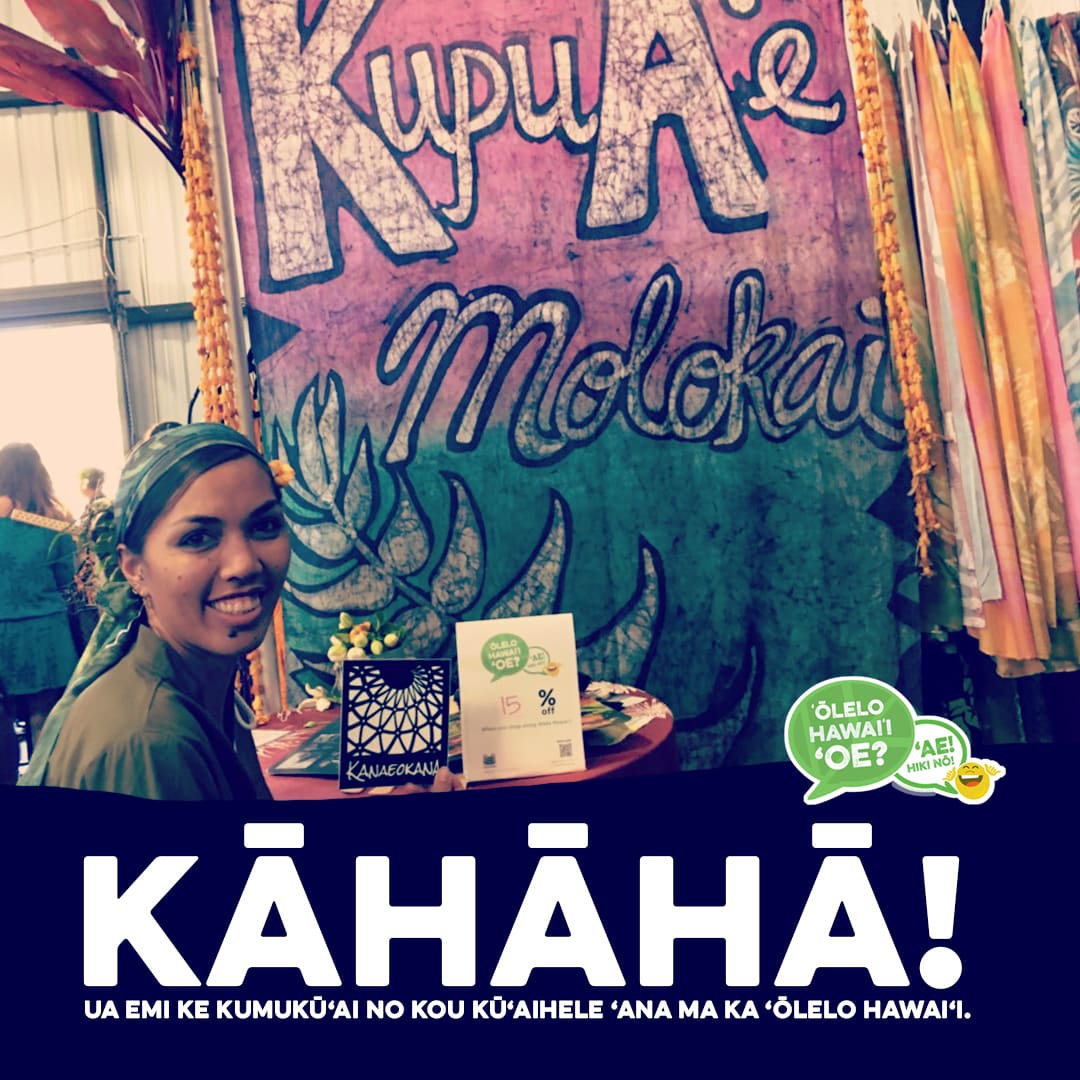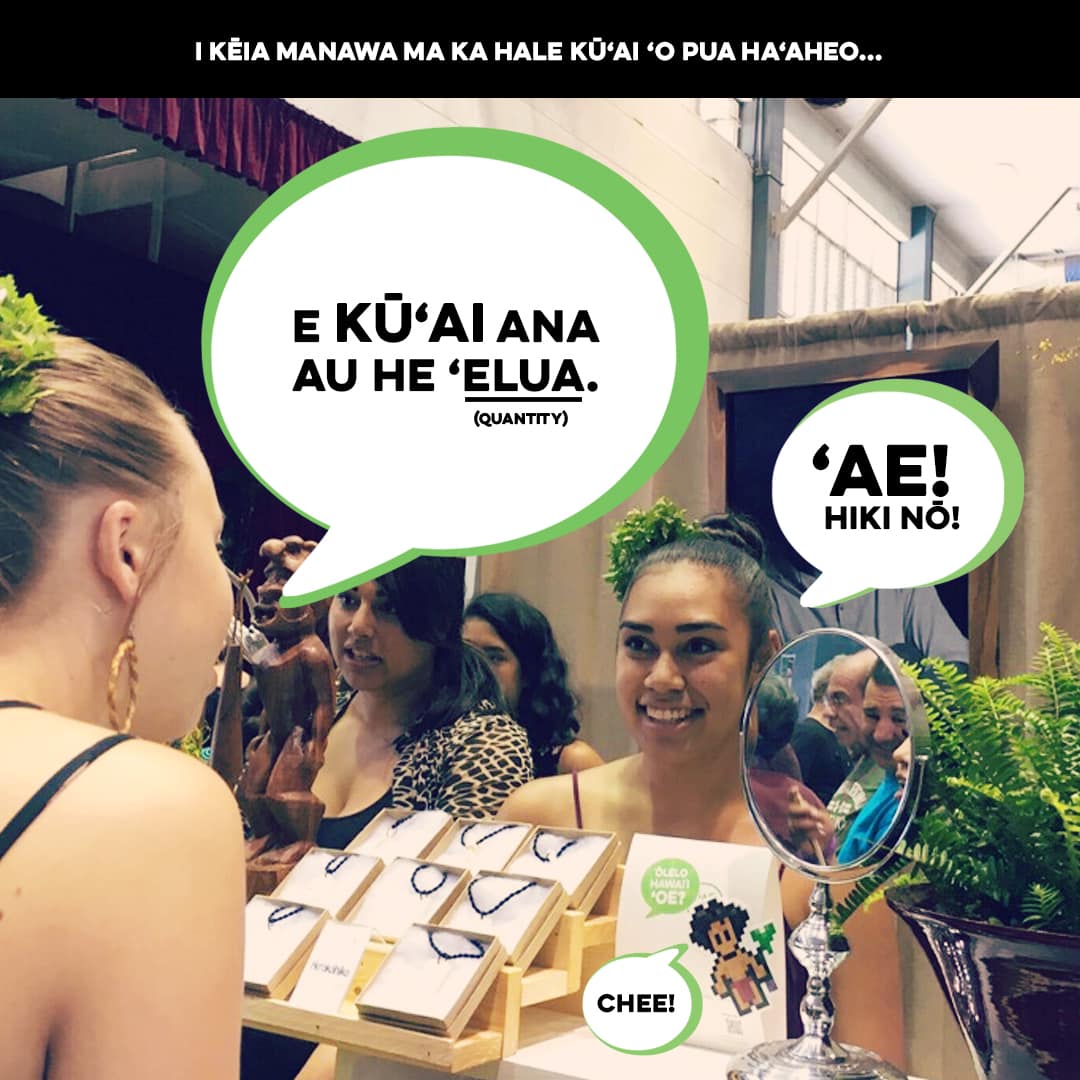‘Ōlelo Hawai‘i ‘Oe?
Hilo, Hawaiʻi — Do you speak Hawaiian? If you do or if you’d like to learn, head to the Merrie Monarch Invitational Hawaiian Arts Fair this Wednesday through Saturday at the Afook-Chinen Civic Auditorium and Butler Building.
In collaboration with the festival, Kanaeokana, the Kula Hawai‘i Network, is launching its “ʻŌlelo Hawaiʻi ʻOe?” (“Do you speak Hawaiian?”) campaign to encourage the use of ʻōlelo Hawaiʻi, the Hawaiian language. It’s doing so by supporting vendors and customers at the festival to conduct their sales and shopping in ʻōlelo Hawaiʻi.
Vendors may offer discounts or free swag to customers who converse with them in ʻōlelo Hawai‘i. A cheat sheet with useful phrases for sellers and shoppers alike will be available from vendors that opt in and online at kanaeokana.net/vocab. It includes handy phrases such as “He makepono nō!” (This is a deal!) or “Ua nani kēnā iā ʻoe!” (That is beautiful on you!).
These aids are provided by Kanaeokana, a newly formed network of ʻōlelo Hawaiʻi, Hawaiian culture, and ʻāina-based schools (preschool through university level) collaborating to strengthen Hawaiian education. One of its goals is to enable and encourage the use of ʻōlelo Hawaiʻi in daily life.
The “ʻŌlelo Hawaiʻi ʻOe?” campaign is led by Kanaeokana members from Hale Kuamoʻo at Ka Haka ʻUla o Keʻelikōlani: College of Hawaiian Language at UH-Hilo, the UH-Mānoa Hawaiʻinuiākea School of Hawaiian Knowledge, the UH-Mānoa College of Education, and Kamehameha Schools.
“Since the 1970s, there’s been growing momentum to re-establish ‘ōlelo Hawai‘i as an everyday language, with thousands of haumāna (students) and ‘ohana (families) choosing to learn the language,” said Keiki Kawaiʻaeʻa, director of Ka Haka ʻUla o Keʻelikōlani: College of Hawaiian Language and participant in Kanaeokana.
“What’s lacking are contexts outside of the classroom and homes where ʻōlelo Hawai‘i speakers are encouraged to apply what they have learned and where new learners can give it a try. To support these efforts, we need to increase the opportunities for people to use Hawaiian in natural language contexts. That’s a major goal of this campaign,” added Kawaiʻaeʻa.
“Our Merrie Monarch Invitational Hawaiian Arts Festival has so much to offer Hawaiian culture enthusiasts,” said Nelson Makua, the director of the arts festival. “This year we’re proud that some of our vendors are ready to engage their customers in ʻōlelo Hawai‘i, when customers approach them using ʻōlelo Hawai‘i. And we’re excited that other vendors plan to listen in and gear up for next year,” Makua added. “We hope ʻōlelo Hawai‘i use will grow every year. That would be our contribution in turning the tide to make ʻōlelo Hawai‘i an everyday language once again.”
“ʻŌlelo Hawaiʻi was the language of business and commerce throughout most of Hawai‘i’s kingdom era, with American, British, Greek, and Chinese merchants speaking both their native language and ʻōlelo Hawaiʻi with their customers,” said Eōmailani Kūkahiko, a faculty member of UH-Mānoa’s College of Education and Kanaeokana participant.
Although an official state language, it is estimated that only 1.7 percent of Hawaiʻi’s population can speak ʻōlelo Hawaiʻi. Merrie Monarch provides a special opportunity for many Hawaiʻi Island families who regularly speak Hawaiian in the home, making Hawaiian the number one used non-English home language.
Kanaeokana is launching its “‘Ōlelo Hawai‘i ‘Oe?” campaign to enable more people to enjoy using ʻōlelo Hawaiʻi in their daily lives. “ʻŌlelo Hawaiʻi ʻOe?” will also be expanded in the near future to interested businesses on all islands as part of Kanaeokana’s multi-year plans to bring to reality a Hawaiʻi where ʻōlelo Hawaiʻi is heard everywhere you go.
What’s new at the Merrie Monarch invitational Hawaiian Arts Craft Fair? Shopping in ‘Ōlelo Hawai‘i!




